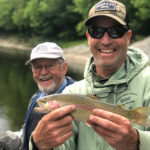 Hi Folks, The trout fishing has been pretty decent this last week. Nice water temperatures. I have recorded water temps. between 59 and 63 degrees. Nice cool nights have contributed to the water temperature. We did receive a lot of rain mid week which stuffed our rivers for a day or two. However, it is nice to have a large volume of water in our streams. Levels are slightly above the average seasonal flow. The number of caddis hatching in the last few weeks has been very prolific. Caddis are of the order Trichoptera. It is estimated that there are approximately 7000 species in the order world wide and 1200 in North America alone. Sounds rather daunting in figuring out which caddis pattern to attach to your tippet. We fly anglers are most concerned with genera Hydropysche and Heliocopsyche or sedges. Caddis are aquatic, slender with a segmented body and a heading with a chewing mouthpart. Adults are mothlike with wings that are sloped like a roof over their back, with thin antennae, and dark to light segmented bodies. I have always found imitating caddis to be fairly easy. I tie subsurface patterns in olive, gray/black, and tan. My favorite dry is the X-caddis in olive, tan, and gray. Flipping rocks in any Vermont stream will produce caddis. It is by far and wide the most common water born insect I encounter on our rivers. Trout love to eat caddis! I keep the Caddis selection fairly simple. I carry patterns in olive, tan, and grey/black tied on #14-#20 size hooks. My dry patterns are either a Vermont Caddis, X-Caddis, Goddard Caddis, and a foam wing caddis. My subsurface patterns are Slaughter caddis pupa, wire caddis, electric caddis, LaFontaine sparkle caddis emerger. On our streams recently, caddis have been hatching throughout the morning when it is sunny with massive egg laying at dusk. I think every trout my guests have landed in the last week have come on caddis patterns. So, next time to you venture out, make sure your box is loaded with caddis patterns. Remember to clean your gear and keep the non-native species at home. Have Fun, Willy
Hi Folks, The trout fishing has been pretty decent this last week. Nice water temperatures. I have recorded water temps. between 59 and 63 degrees. Nice cool nights have contributed to the water temperature. We did receive a lot of rain mid week which stuffed our rivers for a day or two. However, it is nice to have a large volume of water in our streams. Levels are slightly above the average seasonal flow. The number of caddis hatching in the last few weeks has been very prolific. Caddis are of the order Trichoptera. It is estimated that there are approximately 7000 species in the order world wide and 1200 in North America alone. Sounds rather daunting in figuring out which caddis pattern to attach to your tippet. We fly anglers are most concerned with genera Hydropysche and Heliocopsyche or sedges. Caddis are aquatic, slender with a segmented body and a heading with a chewing mouthpart. Adults are mothlike with wings that are sloped like a roof over their back, with thin antennae, and dark to light segmented bodies. I have always found imitating caddis to be fairly easy. I tie subsurface patterns in olive, gray/black, and tan. My favorite dry is the X-caddis in olive, tan, and gray. Flipping rocks in any Vermont stream will produce caddis. It is by far and wide the most common water born insect I encounter on our rivers. Trout love to eat caddis! I keep the Caddis selection fairly simple. I carry patterns in olive, tan, and grey/black tied on #14-#20 size hooks. My dry patterns are either a Vermont Caddis, X-Caddis, Goddard Caddis, and a foam wing caddis. My subsurface patterns are Slaughter caddis pupa, wire caddis, electric caddis, LaFontaine sparkle caddis emerger. On our streams recently, caddis have been hatching throughout the morning when it is sunny with massive egg laying at dusk. I think every trout my guests have landed in the last week have come on caddis patterns. So, next time to you venture out, make sure your box is loaded with caddis patterns. Remember to clean your gear and keep the non-native species at home. Have Fun, Willy

